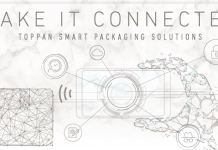Toppan says the communication performance is equivalent to products using plastic film and achieved with new circuit fabrication technology. In addition, fraudulent reattachment is prevented by the antenna breaking when the label is removed.
In a press release datelined 23 January 2023 Tokyo, Toppan announced the launch of its global sales as of the same day, of its eco-friendly near-field communication (NFC) tag label. The new NFC tag label uses paper material as the substrate for the antenna instead of conventional polyethylene terephthalate (PET) film. According the press release, Europe is expected to be a promising market for this type of product due to its high level of environmental consciousness and efforts to replace plastics that are gathering pace there.
In addition to reducing plastic consumption to zero, by switching to paper, a new circuit fabrication technology ensures sufficient communication performance as an NFC device. Taking advantage of the properties of paper as a substrate, the NFC tag label is designed to break when it is removed, making communication impossible and thereby preventing fraudulent use due to reattachment of labels.
The value of the global NFC tag market reached US$ 3.8 billion in 2020, and is expected to reach US$ 15.5 billion by 2030.¹ In addition to increased use in contactless payment systems and supply chain management, this market is driven by factors such as the need for more social distancing as a result of the COVID-19 pandemic.
NFC tag labels are predominantly produced by using metal foil to form an antenna on a plastic substrate, such as PET film. As governments and businesses advance activities to move away from the use of plastic, the market for NFC tags is seeing growing demand for replacing plastic with paper materials that have lower environmental impact. However, achieving sufficient communication performance has been challenging because the electrical resistance of circuits increases when printing methods employing conductive inks, such as widely-used silver nanoparticles, are used to form antennas on paper.
“Toppan’s new NFC tag label meets growing demand for more eco-friendly solutions as the NFC market expands globally,” said Takamitsu Nakabayashi, general manager of RFID/IoT and security development in Toppan’s DX Design Division. “We will expand sales globally, focusing particularly on the European market, where measures focused on reducing environmental impact are gathering pace.”
Plastic-free with communication performance equivalent to conventional products
Aluminum foil with low electrical resistance is used to form an antenna on a paper substrate via a new circuit fabrication technology combining laser edge technology with a roll-to-roll web handling process. This eliminates plastic from the NFC tag while maintaining the required communication performance. If a paper substrate is used instead of a PET film substrate for a million standard size NFC tag labels (80 mm x 45 mm), the consumption of plastic resin can be reduced by approximately 110 kilograms, says Toppan.
Label thickness reduced by 30%
Due to a layer structure in which the paper substrate doubles as the surface layer material, the new eco-friendly NFC tag label is 30% thinner than Toppan’s existing products with PET film substrates. This means that documents or the like to which NFC tag labels have been attached do not become bulky when stacked.
*Lamination of a separate printed layer is required when applying color printing to the label surface.

Toppan’s new eco-friendly NFC tag label using a paper-based substrate (right)
Illustration Toppan
Brittle paper material helps to prevent fraudulent reattachment

fraudulent reattachment by breaking when removed
Image Toppan
The eco-friendly NFC tag label has been designed to break, making communication impossible, when an attempt is made to remove it from an item to which it has been attached. This enhances security by preventing fraudulent use via reattachment.
Price similar to NFC tag labes using PET substrates
The price of the new eco-friendly NFC tag labels is similar to that of NFC labels using PET substrates. Separate quotations are required when color printing is applied to the surface.
¹Source: Allied Market Research 2021











